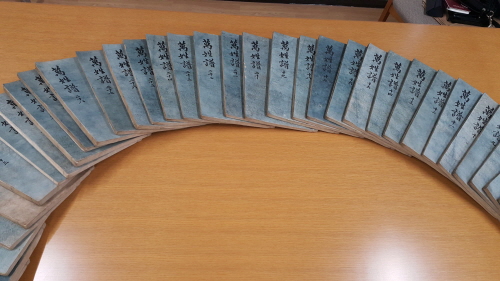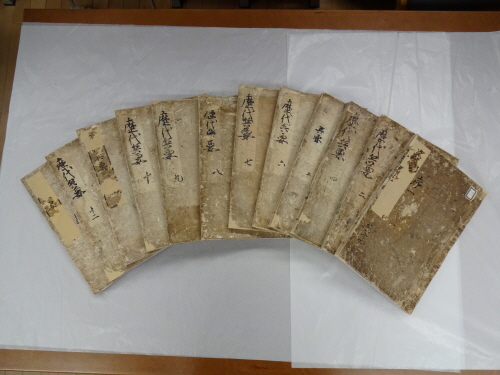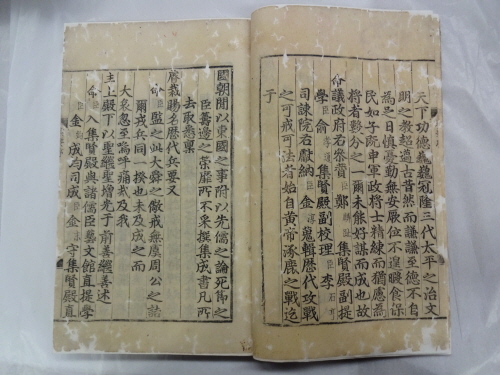King Seonjo’s Letter of Recognition to his Wartime Refuge Horseguard Found in Japan
What the KU Center for Overseas Resources on Korean Studies found out in Kyoto University’s old literature

The Center for Overseas Resources on Korean Studies at the Korea University Research Institute of Korean Studies examined the old Korean literature in the possession of the Kyoto University Library, which revealed that the literature had a large number of documents and books of historic value: Ho-Seong-Gong-Shin Gyo-Seo (扈聖功臣 敎書, Royal Letter of Recognition), awarded to King Seonjo’s royal horseguard Yeon Oh (吳連)); Yeok-Dae-Byeong-Yo (歷代兵要), printed by means of metal types Gyeong-Oh-Ja molded based on Ahn-Pyeong-Dae-Guhn’s font; Dae-Hak-Yeon-Ui with King Sejong’s seventh son Pyeong-Won-Dae-Guhn’s personal stamp on it; and a mahn-sung-bo (萬姓譜) that records the largest number of Korean surnames among all others of its kind.


King Seonjo awarded 86 loyal men who served him in his wartime refuge to Uijoo with the Ho-Seong-G
ong-Shin in 1604. It is known that only nine copies of it remain in Korea, six of which have been designated as National Treasures by the government. As all of the nine copies were awarded either to Moonshin (文臣, high-level administrative officials) or to Uigwan (醫官, medical specialists), the one recently found in Japan – also known as Oh-Yeon-Gyo-Seo – is currently the only Royal Letter of Recognition granted to an Yima (理馬, a royal horseman stationed at Sabokshi (司僕寺)).
The letter awarded to Yeon Oh indicates that King Seonjo appreciated Oh’s service despite his humble social rank. “In serving their King and tending to the superior, the noble and the humble should not be different. Thus, I understand that I also should not discriminate the noble and the humble in granting rewards and in recognizing their services. I hereby express my sincerest gratitude,” the Letter reads, “When the barbarians from the East [Japanese] brutally invaded the Kingdom and the Royal Family took refuge toward the West in a hurry, when all villages – large and small – are burned to ashes, and when most of the royal servants and people fled away and hid like scared birds and beasts, you, despite your humble origin, never let your King be frustrated, kept doing your job to reign the king’s and prince’s horses, and served the Royal Family with the same heart in spite of all obstacles.

Yong-Sa-Ho-Jong-Rok (龍蛇扈從錄) states that Yeon Oh “followed the Royal Carriage as a Jeong-Byeong (正兵) in the province Buyeo (扶餘).” Professor Park Youngmin (KU Research Institute of Korean Studies) explained that a Jeong-Byeong refers to a full-time enlisted soldier, and that an ordinary layman, Yeon Oh, joined the army, where he happened to serve King Seonjo.
Even today, it is said that King Seonjo’s award of letters of recognition was highly unfair due to the fact that only 18 people, among all the military personnel who devoted their lives to protect the King, received the letters – the Seon-Mu-Gong-Shin (宣武功臣) – moreover, any high-profile generals and leaders of the Righteous Army (義兵, non-governmental army who voluntarily gathers for the sake of justice) were even excluded from the Seon-Mu-Gong-Shin. Still, King Seonjo tried not to discriminate between the noble and the humble as long as they properly served the King. This is noteworthy because the high officials in the Royal Court were mostly unhappy with such a rank-indiscriminate policy – unhappy enough to deplore the Kingdom where “as many as 20 vulgar servitors received a Ho-Seong-Gong-Shin.” Most copies of the 1604 Ho-Seong-Gong-Shin in Korea have been designated either as National Treasures or National Cultural Heritage artifacts. The letter awarded to Yeon Oh – “Oh Yeong Gong-Shin Gyo-Seo” – was written by Shin Jije (申之悌). Upon receiving the letter, Yeon Oh was offered the title of Seok-Sung-Guhn (石城君) and thus became the progenitor of the Seok-Sung-Guhn Sect of the Oh Family.
Yeok-Dae-Byeong-Yo (歷代兵要) printed by the printing types Gyeong-Oh-Ja molded after Ahn-Pyeong-Dae-Guhn’s writings
The Center found the only copy of Yeok-Dae-Byeong-Yo printed with Gyeong-Oh-Ja – known as “the printing type of the ominous shadow.” Gyeong-Oh-Ja, produced based on the writings of Ahn-Pyeong-Dae-Guhn, one of the greatest calligraphers of that time, is also called “Ahn-Pyeong-Ja” (安平字) after his royal name (君號).
Upon the demise of King Sejong, the princes printed Buddhist scriptures to pray for the repose of the deceased. High-level officials, who believed in Confucian teachings, rose against the printing of the Buddhist text, which pushed King Munjong – Sejong’s successor – to abolish the national publishing center Jujaso. But Sejong’s princes produced the Gyeong-Oh-Ja and continued to print the Buddhist text at Jeong-Um-Chung (正音廳).
Gyeong-Oh-Ja was praised as “the best types for book printing” for each of its types reflected the stylish writings of Ahn-Pyeong-Dae-Guhn to its best. Professor SIM KYUNG HO at the Department of Classical Chinese said of it that “Gyeong-Oh-Ja was used only for six years (1450-56), for King Sejo melted it after he usurped the Royal Throne – simply because its font was molded after Ahn-Pyeong-Dae-Guhn’s.” Since it was used for such a short time, there remain only six pieces of Gyeong-Oh-Ja in the world.
Dae-Hak-Yeon-Ui (大學衍義) with Pyeong-Won-Dae-Guhn’s Stamp
Among the collection of literature was a copy of Dae-Hak-Yeon-Ui with King Sejong’s seventh son Pyeong-Won-Dae-Guhn’s personal book stamp Geun-Haeng-Ji-Dahng (謹行之堂) on it. This copy is of special historical value, in that it is what Pyeong-Won-Dae-Guhn, who died early at the age of 19, read with his own eyes. Dae-Hak-Yeon-Ui, a must-read for crown princes, is known to have been loved by King Sejong himself. Historical records indicate that Pyeong-Won-Dae-Guhn mastered such Confucian classics as Shi-Gyeong (詩經) and Yeh-Gi (禮記), as well as Dae-Hak-Yeon-Ui, who stamped books he read with Geun-Haeng-Ji-Dahng, the name of which is after his agnomen “Geun-Haeng-Dahng.”
Books stamped with Geun-Haeng-Ji-Dahng are highly rare. The very copy of Dae-Hak-Yeon-Ui found in Kyoto University Library was printed by Gahp-In-Ja (甲寅字), known as the most sophisticated printing types in the Joseon Dynasty.
A Mid-19th Century Mahn-Sung-Bo (萬姓譜) that contains the largest number of people’s names
The Center also discovered 40 copies of the mid-19th century Mahn-Sung-Bo (萬姓譜, Encyclopedia of Notable Families and their Genealogies). Produced in the late Joseon, it also recorded the names of daughters and sons-in-law. Chief Classical Literature Researcher at the Academy of Korean Studies (AKS) Ahn Seung-jun, who participated in the examination, stated that the newly found copies have 3 to 4 times more data, making them “some of the largest Joseon biographical dictionaries, through which we can even go over the registered persons’ civil service examination records, career development trajectories and marital relationships, as well as their general social networks.”
The examination into Classical Korean Literature in the possession of Kyoto University Library has been planned and conducted as part of a Center for Korean Studies Materials project of the Academy of Korean Studies. Professor Woo Bong Chung from the Department of Korean Language and Literature, who is in charge of the project, stated that “The AKS Center for Resources for Korean Studies project has reached its 10th year now. But because its proposed extension has not passed governmental budget review yet, its overseas research is going to be tentatively suspended after this coming June. We hope that our research into overseas literature, which is a rich repository of Korean studies materials, could be continued over the long run.”



